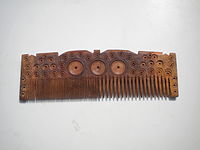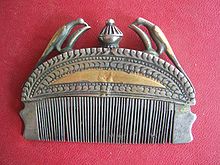- Comb
-
A comb is a toothed device used in hair care for straightening and cleaning hair or other fibres. Combs are among the oldest tools found by archaeologists[1] , having been discovered in very refined forms from settlements dating back to 5000 years ago in Persia.
Contents
Description
Combs can be made out of a number of materials, most commonly plastic, metal, cotton material or wood. Ivory and tortoiseshell were once common but concerns for the animals that produce them have reduced their usage. When made from wood, combs are largely made of boxwood, cherry wood or other fine-grained wood. Good quality wooden combs are usually handmade and polished.
Combs can vary in shape according to function. Hairdressing combs may have a thin, tapered handle for parting hair and close teeth. Common hair combs usually have wider teeth half way and finer teeth for the rest of the comb.
A hairbrush, which is larger than a comb, is also commonly used for shaping, styling and cleaning the hair.
Uses
Combs can be used for many purposes including: securing long hair in place; decorating the hair; matting sections of hair for dreadlocking; or keeping a kippah or skullcap in place. In Spain, a Peineta is a large decorative comb to keep a mantilla in place.
In industry and craft, combs are used in separating cotton fibres from seeds and other debris (the cotton gin, a mechanized version of the comb, is one of the machines that ushered the Industrial Revolution). A comb is used to distribute colours in paper marbling to make the swirling colour patterns in comb-marbled paper.
Combs are also a favorite spot for police investigators to collect hair and dandruff samples that can be used in ascertaining dead or living people's identities, as well as their state of health, toxicological profiles, and so forth.
Making music
Stringing a plant's leaf or a piece of paper over one side of the comb and humming with cropped lips on the opposite side dramatically increases the high-frequency harmonic content of the hum produced by the human voice box, and the resulting spread sound spectrum can be modulated by changing the resonating frequency of the oral cavity.
This was the inspiration for the kazoo. Moreover, the comb is also a lamellophone. Comb teeth have harmonic qualities of their own, determined by their shape, length, and material. A comb with teeth of unequal length, capable of producing different notes when picked, eventually evolved into the thumb piano and musical box.
Afro pick
This type of comb has loose teeth and is primarily used on kinky, coil hair. In the 1970s, it was sometimes worn in the hair.
Nit comb
Specialized combs such as "flea combs" or "nit combs" can be used to remove macroscopic parasites and cause them damage by combing. A comb with teeth fine enough to remove nits is sometimes called a "fine-toothed comb", as in the metaphoric usage "go over [something] with a fine-toothed comb", meaning 'search [something] closely and in detail'. Sometimes in this meaning, "fine-toothed comb" has been reanalysed as "fine toothcomb" and then shortened to "toothcomb".[2]
Hygiene
Sharing combs is a common cause of parasitic infections, as one user can leave a comb with plenty of eggs or even live parasites, facilitating the transmission of lice, fleas, mites, fungi, and other undesirables.
Images
-
A set of combs found on the 16th century ship Mary Rose
-
A modern plastic comb with a handle
-
Solokha comb, Scythian, ca. 400 BC (Hermitage Museum)
-
Changzhou combs produced also for decorative purposes
See also
References
- ^ S. Ashby 2011 An Atlas of Medieval Combs from Northern Europe, Internet Archaeology 30, http://intarch.ac.uk/journal/issue30/ashby_index.html
- ^ WSU.edu
External links
- H Morewitz (2008), "A Brief History of Lice Combs", Nuvoforheadlice.com
- TheOriginOf.com, (n.d.), "The Origin of Combs"
Categories:- Early musical instruments
- Hairdressing
- Toiletry
- Domestic implements
-
Wikimedia Foundation. 2010.









